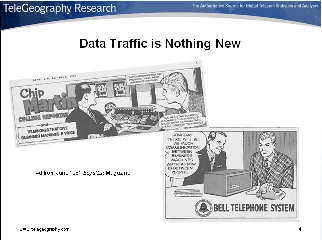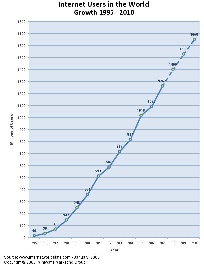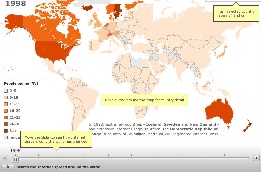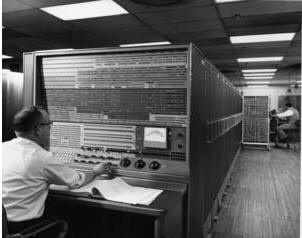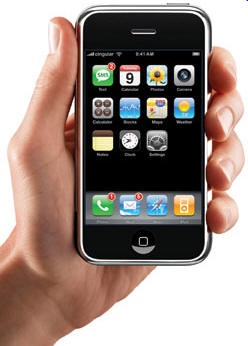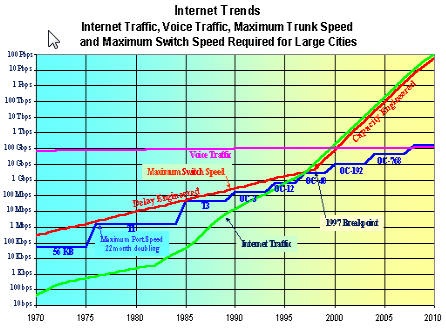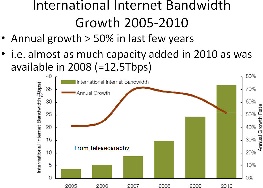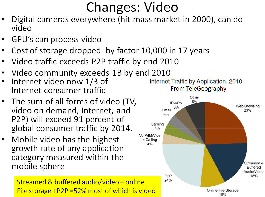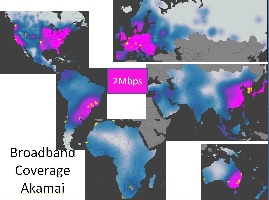Syllabus of Lecture Series
Internet and Africa
See http://www.slac.stanford.edu/grp/scs/net/talk10/helwan.ppt
- The World Cup and Africa
- Impact of Cable Cuts
- Impact of connecting Sri Lanka to TEIN3
- Case study on Pakistan
Internet History, Trends and Futures
See Internet History
History
- 1961 Vision from AT&T (courtesy of Telegeography) computers will talk to one another, at the time via data modems.
Chip: "You mean two business machines thousands of miles apart can actually talk to each other by telephone".
Company person: "Some day there will be as much communication between business machines as there now is between people".
- 1965: Larry Roberts and Thomas Marill create the first wide area connection via telephone line, turns out to be inefficient and costly. Kleinrock predicts that packet switching (developed by Baran, Davies, Kleinrock et. al. is more promising)
- 1969: the original Internet created and had 4 nodes, UCLA, Stanford Research Institute, MIT, Utah, 50kbit backbone (today a modem nb scaling up a million times) Jan 83 400 nodes, now 750M
- Built as a collaboration of global proportions, independent stand on own, self managed autonomous systems (Bill Cheswick autonomous map 1999) , decentralized (chaotic, no central control/management cf phone system), best effort, no guarantees, recovery from losses, pipelining (TCP), host flow control, checksums, non-proprietary (c.f. SNA, DECnet, XNS …), little focus on security (if had focused on this might never have happened), simple black boxes (routers connect nets) that do not retain information about the individual flows, packets inside envelopes, layering (independent of each other, i.e. middle layers don’t know if lower layers are wireless, satellite, copper, fibre, upper layer independent of applications cf purpose designed TV broadcast networks, cable networks, telephone network, only end device knows what the contents mean).
Successes
- Growth in usage in last decade, see http://news.bbc.co.uk/2/hi/technology/8552410.stm
- 1.6B users visible in 2010, large number hiding behind FW, current usage largest group in China and still small % penetration (tells where products go), 75% of world still to connect, mobiles big help when in research domain)
- CPUs early 60’s ~ 50 years ago IBM Stretch 1.2MIPS, $8M vs an iPhone:
- The smartphone is much smaller, i.e. it fits in the hand versus 2500 sq. feet;
- The smartphone weighs 5 oz. versus 40,000lbs;
- The smartphone uses 10,000 times less power;
- The smartphone is a thousand times faster at 1/100,000th of the cost.
- WANs 1960s 75bps modems, now 10-100Gbps, i.e. billion times faster (see http://www.ziplink.net/users/lroberts/IEEEGrowthTrends/IEEEComputer12-99.htm)
- voice long ago overtaken by data,
- trunk speeds roughly double every 22months (driven by Moore's law)
- Dense Wave Division Multiplexing (DWDM) caused breaking point in 1998 then double every 6 months
Problems:
- Address space IPv6 (IPV4 only an experiment so 32 bits =4 billion addresses were fine, but went into production)
- Mobility (used to be to connect big computers that do not move around, now as move around need to change IP address), persistence, presence, more than best effort (QoS), mesh & sensor nets, delay and disruption tolerance (Internet does not do well in these cases), allow device to move with different IP addresses (today looks like a hi-jack so need to have mechanisms to establish trust between parties if allow dynamics), also in mobile world the topology changes(TCP/IP OK for links going up and down) not well solved, persistent connections do not exists since no session layer so hard to re-establish a session at the place where it left off, self-organised nodes discover each other but bad guy may join how does one stop this, how does one trust the others – e.g. military if post over-run and bad guy gets device she can join, how to stop it.
- Trust
- spam, viruses, malware, worms, trojan horses, DOS, DDOS ...,
- Not even safe in space: In 2008, the International Space Station was hit by a computer worm that infected laptops onboard the orbiting mission after being brought on board by one of the Russian crew.
- mistakes of routing, weak OS, naïve browsers and users,
- DNS has vulnerabilities so need digital signatures to prevent poisoning and directing traffic where it does not belong (DNSSEC)
- not everyone in the general public has everyone else’s best interests in mind, initial trust relationship badly broken
- basic system has no authentication, authorization, accounting
- Lack of tools for strong authentication and identification are needed for some applications (e.g. safe to use the cloud)
- organized crime, state sponsored intelligence gathering, privacy.
- Freedom of information vs privacy, wikileak, elections, riots,
- Privacy: how much information is say Google gathering about you (every email if use gmail is saved, search information etc.)
They know who your friends are, where you live, where you work, and where you spend your free time. They know about your health, your love life, and your political leanings. These days they are even branching out into collecting your realtime GPS location and your DNS lookups. In short, not only do they know a lot about what you're doing, they also have significant insight into what you're thinking. see http://www.googlesharing.net/
- spam, viruses, malware, worms, trojan horses, DOS, DDOS ...,
- performance at first just getting it to work was a major challenge, now time to think of how to improve performance and it is difficult to create a new network. Think back to start of Internet, at the time there was a functioning worldwide network = the telephone net so how could another one take over, but it did.
- Address devices inside an end point
- Broadcast turned into unicast, Multicast could be more efficient for some apps
Next gen Internet:
- Internet now critical to global economy
- To borrow from John Lennon: "Imagine there's no latency, no spam or phishing, a community of trust. Imagine all the people, able to get online".
- Goal: Their goal is audacious: To create an Internet without so many security breaches, with better trust and built-in identity management. Researchers are trying to build an Internet that's more reliable, higher performing and better able to manage exabytes of content. And they're hoping to build an Internet that extends connectivity to the most remote regions of the world, perhaps to other planets.
- Youth of today brought up with very different expectations (what’s a wired phone, a payphone, a modem, typewriter, encyclopedia); => messaging, Google searches, Multimedia Internet, video communication (YouTube), Internet access everywhere, mobility, virtual worlds, social networking (Facebook, Twitter), video games, shared information (anyone can publish) and they are tomorrow’s leaders.
- In 1998 75% of all Internet users were Americans, now < 15%. The complexion of the Web - its users, their desires, their languages, points of entry and experiences - has subtly and not-so-subtly changed. All these new online participants bring with them different values, social norms, and styles of expression. Today's Internet is increasingly a reflection of the world's cultures and its governments, which often have very different ideas about how to shape what happens online. Has its open architecture become so frightening to some users that they would prefer to return to closed networks? How will varying ideas about privacy, identity, anonymity and democracy shape the Internet of the future? Is the free and open Internet our fathers fought to build over the objections of commercial giants, soon to be shaped more by corporations and governments than by individual creativity and the free flow of ideas? “Not your fathers Internet – Redefining Digital culture”, Laura Sydel, talk at Computer History 8/19/2010. For some examples see: http://www.networkworld.com/slideshows/2010/080910-govt-internet.html?source=NWWNLE_nlt_daily_pm_2010-08-06#slide3
- Available everywhere (ubiquity):
- end 2010 60% of US commercial aircraft (out of 3500 total planes) will have WiFi (Bloomberg Business Week Jul 12-18, 2010, market intelligence firm In-Stat); revenue from in-flight broadband 2009 - $7M, 2010 = $95M.
- Smartphones
- Trends from Telegeography and Akamai
- Higher speeds 40G (data center), 100G (carrier & longer term, Infinera deliver 2012), 40/100G Ethernet 802.3ab standard ratified 6/17/2010, products ship by year’s end.
- History: 1973 Metcalf writes memo, 1976 1st paper published, 1979 Metcalfe founds 3COM, 1985 IEEE takes over Ethernet standards, 1986 Ethernet over yellow coax cable, 1989 Kalpana ships first switch, 1991 twisted pair, 1994 Ethernet over fibre, 1995 100Mbps Ethernet, 2002 10Gbps, 2010 100Gbps. Router interfaces becoming available but costly (see http://www.networkworld.com/news/2010/090110-brocade.html?source=NWWNLE_nlt_daily_am_2010-09-02)
- Costs trans-atlantic vs trans-pacific and intra-asian routes Lease 10Gbps NY-London $9K-20K/month vs Tokyo-LA $65K-80K (Telegeography), getting closer 3% annually vs 21%_
- Cisco predicts that the biggest driver for the traffic increase will come from video, which will account for roughly 64% of all mobile data traffic in 2013 and 90% of all Internet traffic. In 2008, video traffic averaged around 13,000 TB per month, or roughly 39% of all mobile traffic. By 2013, video traffic will increase by more than 100 times and will average around 1.3 million TB per month, Cisco projects.
- Broadband (DSL, Cable FTTx)
- Size of web pages
- VoIP, Skype, MOS, QoS
- Initially to save phone usage costs, potentially higher quality (bandwidth not limited to 3kbps unless have to use TDM en-route), hi quality voice important for conveying subtleties, ability to understand accents/dialects (think outsourcing), poor quality is main reason not use cell-phone as primary home phone (http://www.polycom.com/global/documents/whitepapers/can_you_hear_what_i_mean_polycom_delivers_hd_voice.pdf). VoIP now a standard (no longer research or disruptive technology). 2010 IDC estimates 40M consumers in US will use VoIP to communicate (e.g. important for out-sourcing)
- Skype uses open internet, being used for business, travelers
- New integration of voice with other apps/services, e.g. RFID tag to allow a lost suitcase to call home, voice recognition
- MobileTV (Google TV)
- Mobile TV growth estimated at 50-55% CAGR, end 2008 75M users and 45% in S. Korea and Japan. Adoption in India, China and US are enormous potentials, killer app in Asian markets?
- End User devices
- OLPC, netbooks, Smartbooks(iPads, Kindles), smartphones
- Smartbooks: mobile device falls between Cell phones and netbooks; battery life 1 day, uses lower power processor (e.g. ARM), some have wireless or Internet access, more general iPAD providing heavy competition resulting in price slashing to under $200 (expect under $100 in 2011 for 6" model SJ Mercury 8/21/2010 page C3). Sales in 2010 expect 10 million after 4 million in 2009 (Austin research firm Display Search).
- Amazon e-Books have already overtaken hardcover sales.
- Nb iPAD timing is just right. Go introduced PenPoint pad in late 1980s (6 years and $75M in venture capital Go evaporated) then Apple developed Newton, then Palm developed the Pilot. Timing required faster processors, lower power, lower component costs, the Internet and robust wireless networks) SJ mercury Sun Jul 25, 2010. See http://sports.tmcnet.com/news/2010/07/25/4918626.htm
- Forrester estimates tablets will outsell netbooks in US in 2013. Tablets will constitute 20% of all PC sales in 2015, sales expect to reach 9 million by end 2010.
- iPAD designed as a media consumption device for consumers, but also providing a unique mobile computing platform for business as well. Bloomberg reports that Wells Fargo has approved the iPad for business use, and that SAP AG, Tellabs Inc., and Daimler AG's Mercedes-Benz unit are all using the Apple iPad for various tasks ranging from e-mail access to empowering the mobile sales force with the tools to approve shipping orders or verify auto financing options. Apple has sold more than three million iPads already, and analysts estimate that it is on track to continue selling roughly two million more tablets per month. It's a lot of estimates and speculation, but if the AT&T statistic that four in ten iPhones are purchased for business use carries over to iPads, that would mean that 1.2 million of the iPads are currently being used for business purposes--and that 800k more are being added each month. A recent survey found that eight in ten business professionals rely on their smartphone as the primary business communication platform, and would rather give up coffee than surrender the smartphone. The survey also indicated that 34 percent of respondents use on the smartphone more than a PC for business computing, and that seven percent leave the laptop at home and rely purely on the smartphone when traveling.
- OLPC, netbooks, Smartbooks(iPads, Kindles), smartphones
How does the Internet Work
See http://www.slac.stanford.edu/grp/scs/net/talk09/ictp-perform.ppt
How is the Internet Performing
See http://www.slac.stanford.edu/grp/scs/net/talk09/ictp-perform.ppt
- See http://event.on24.com/clients/default/presentation/default.html?titlecolor=000000&eventid=228779&sessionid=1&username=&partnerref=&format=wmaudio&key=8BDA86314FDA5E7498C5560D259119A0&text_language_id=en&playerwidth=930&playerheight=600&eventuserid=38925402&contenttype=A&mediametricsessionid=34698414&mediametricid=592687&usercd=38925402&mode=launch
- Top sources of attacks
- Top traffic sources
- Internet Traffic Growth, capacity and pricing trends see http://www.bluecoat.com/doc/14454
- Browser share, see http://www.netmarketshare.com/browser-market-share.aspx?qprid=1
- See http://www.netindex.com/ for Household broadband rates
- Speeds
- June 23, 2010 Tyco Subcom demos 40-Gbps * 64 ~ 2.65Tbps on fibre pair (4* original design capacity) UK-NJ 6400km.
- 10Gbps still experimental/bleeding edge, early adopters 2-3 years, what will the reach be?
- Cf 40-100Gbps see http://www.lightwaveonline.com/networking/video/51932282.html?player=32673423001&title=1709855864
- Higher speeds being driven by Switched Ethernet Services being used by wireless phone carriers for backhaul. June 24 Verizon trials 100Gbps with Alcatel-Lucent
- Undersea cables see http://www.pccwglobal.com/network/network-map
Network Measurements
See http://www.slac.stanford.edu/grp/scs/net/talk09/ictp-measure.ppt
- Anomaly detection
- Alerting
Measuring the Digital Divide (ppt, video
See http://www.slac.stanford.edu/grp/scs/net/talk09/ictp-divide.ppt
Mobile Computing and Mobile Phones
How to Accelerate your Internet
- Policy
- Measurement
- Cloning
- Hotmail (see work desktop)
Geolocation
See Geolocation
Network problem diagnosis for non-networkers
See Diagosis
